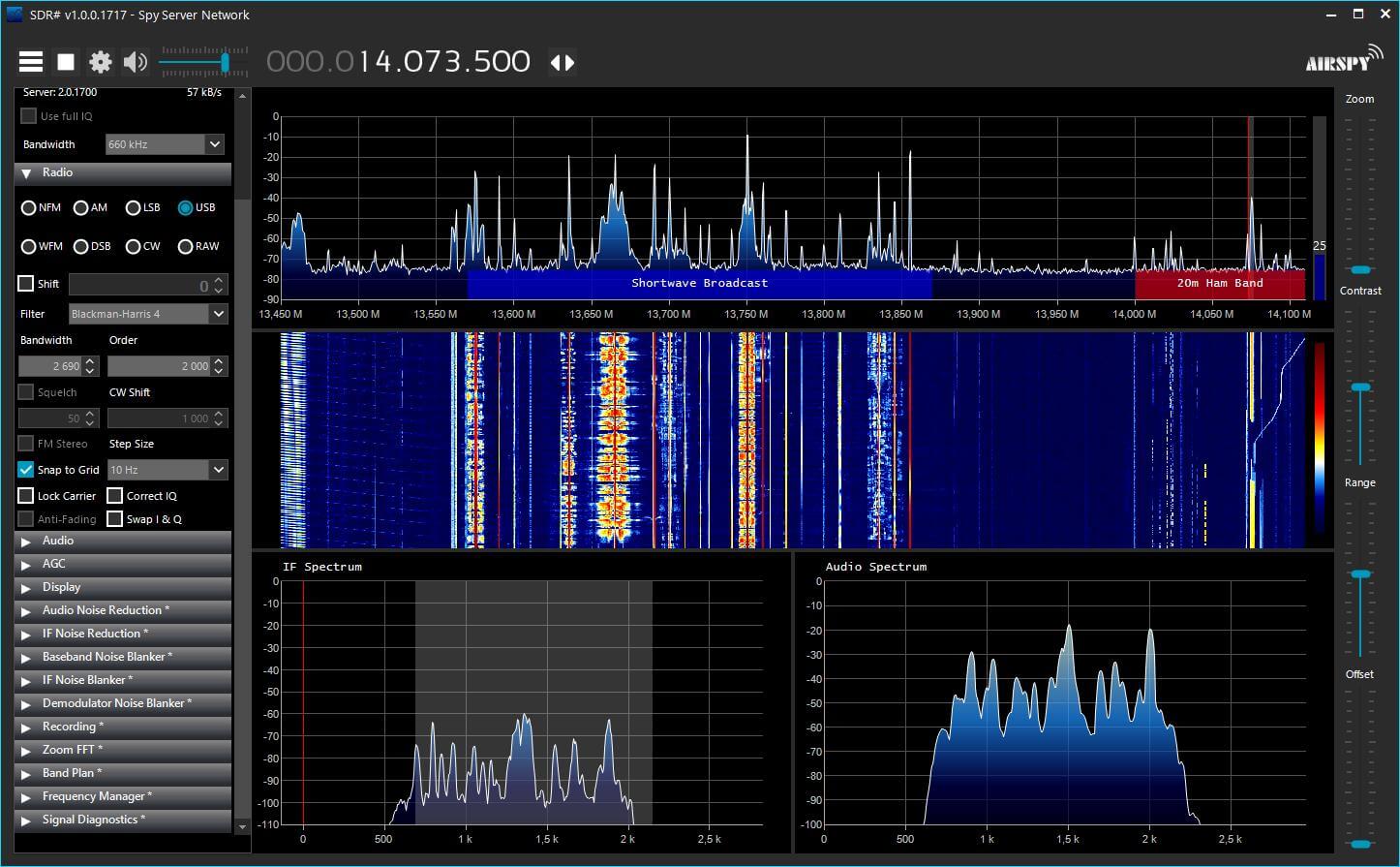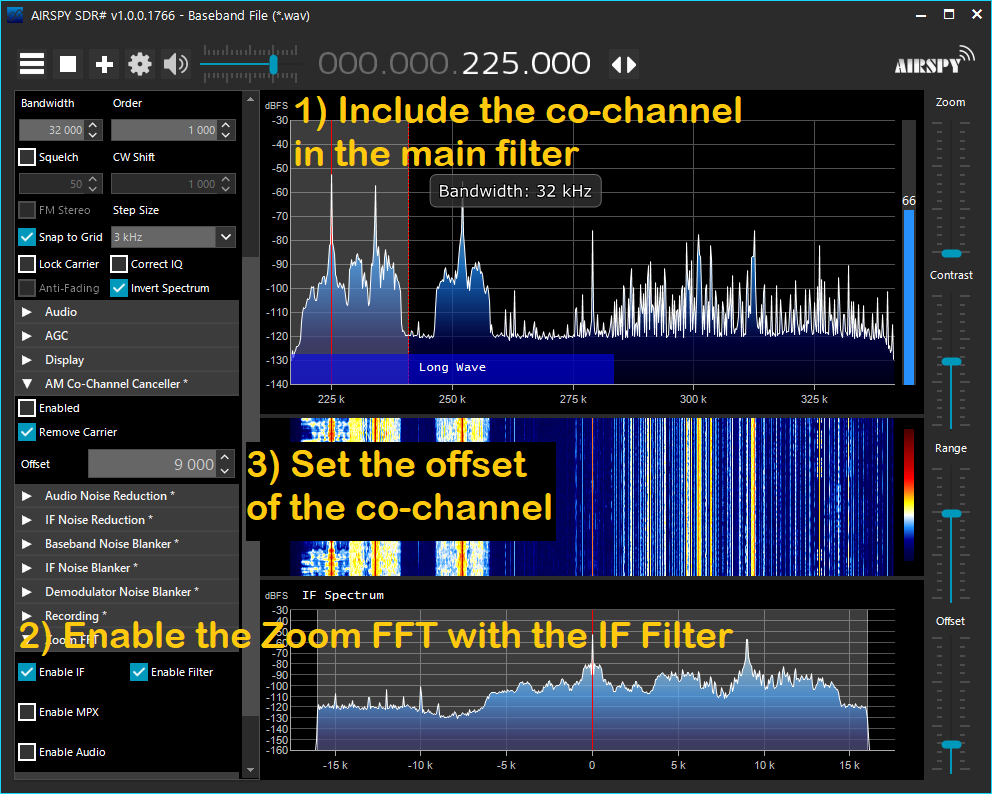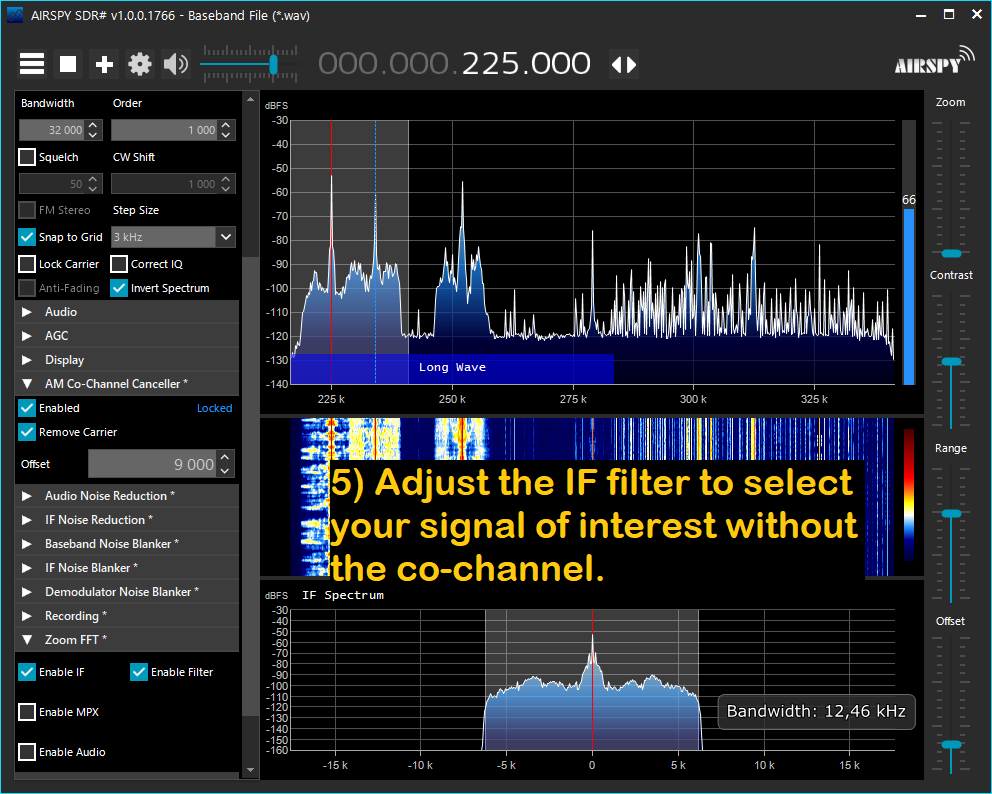
A version of AirSpy’s popular SDR# software, showing the dark mode interface introduced in 2019. SDR# is always evolving, and the latest new tool is the Co-Channel Canceller.
It’s easy to take for granted the magical math that happens in Software Defined Radio. Occasionally though a breakthrough occurs which really grabs our attention, thanks to the hard work and bright minds of the designers behind the receivers and the software.
On the software side, the first series of “wow” moments happened for me in 2007-2008 when Nico Palermo of Perseus SDR fame expanded the program’s alias-free bandwidth incrementally from a modest (but impressive for the time) 100 kHz all the way up to the current 1600 kHz coverage.
The top-end 1600 kHz bandwidth was a game changer which allowed medium wave DXers the opportunity to record IQ-WAV files of the entire band for later review, analysis, and DXing. It’s even more impressive considering this expansion was done without any additional hardware or receiver updates.
What did Nico charge Perseus owners for this incredibly useful expansion of spectrum and waterfall bandwidth? Nothing! The program with its much improved features continued freely available to previous and new Perseus SDR owners.
Now in 2020, Youssef Touil, AirSpy’s hardware and software developer, brings a “killer feature” to his own SDR program named SDR#, for the benefit of medium wave DXers: the Co-Channel Canceller. The cost for this innovative tool? Yep, it’s a free addition to SDR#.
What are the benefits of the Co-Channel Canceller? This question is best answered by listening to three examples published by Youssef on his Twitter feed.
Read the descriptions below and listen to the brief audio files. In each example the Co-Channel Canceller is turned on and off a few times:
Experimenting with the Co-Channel Canceller. Here, the plugin is cancelling 594 kHz and letting 596 kHz thru. It's workish, but still needs some polishing. Check the audio!#Airspy #sdrsharphttps://t.co/h5TMo4OlQL pic.twitter.com/koMKqQR1tW
— prog (@lambdaprog) October 15, 2020
So, the Co-Channel Canceller can also reject the dominant carrier to some extent and unburry the DX signals. Interesting side effect.
Check the audio!#airspy #sdrsharphttps://t.co/vqDAIsobGm pic.twitter.com/f1WrsXIs3b— prog (@lambdaprog) October 15, 2020
Yep. Works also for broadband noise. #airspy #sdrsharphttps://t.co/rjBTuk16Kg pic.twitter.com/mGp5I2vUjq
— prog (@lambdaprog) October 15, 2020
For the first example above, I suspect the 594 kHz station is Saudi Arabia’s Radio Riyadh, and the off-channel 596 kHz signal is Al Idaa Al-Watania from Morocco. It’s impressive that the 50 kw 596 station can be uncovered to any degree, as Radio Riyadh is a whopping 2000 kw!
In the AirSpy Groups.io forum, Youssef clearly illustrates the steps needed to initiate the Co-Channel Canceller. I’ve reproduced his screenshots below:


 I’ve only just begun to explore the possibilities of the Co-Channel Canceller tool, but it holds promise of helping to reveal and identify hopelessly buried co-channel or adjacent channel stations. Not only does it work “live” in real time reception, it functions well with recorded IQ-WAV files too! Checkout the newest version of SDR# and give this new feature a try. I can imagine situations where this tool could be highly useful at times for the shortwave DXer also.
I’ve only just begun to explore the possibilities of the Co-Channel Canceller tool, but it holds promise of helping to reveal and identify hopelessly buried co-channel or adjacent channel stations. Not only does it work “live” in real time reception, it functions well with recorded IQ-WAV files too! Checkout the newest version of SDR# and give this new feature a try. I can imagine situations where this tool could be highly useful at times for the shortwave DXer also.
Thanks, Youssef, for this brilliant tool, which you’ve included free with the newest SDR# !
I encourage radio hobbyists to support AirSpy’s efforts to advance the state-of-the-art. The diminutive AirSpy HF+ Discovery receiver is not only a reasonably priced SDR to use with SDR#, it’s a top performer and a recipient of the World Radio TV Handbook’s Best Value SDR award for 2020.
Guy Atkins is a Sr. Graphic Designer for T-Mobile and lives near Seattle, Washington. He’s a regular contributor to the SWLing Post.

I want to reed 868 Ghz Rf signaal can y do that whit this software ?
This is my step by step guide to using the cochannel interference eliminator https://youtu.be/_4x_hgkbcjg
For SDRuno users, check out the software notch filters which allows up to 4 unwanted signals int he passband to be removed: https://youtu.be/5K92dG2sedw – this is documented on page 55 of the SDRuno manual: https://www.sdrplay.com/docs/SDRplay_SDRuno_User_Manual.pdf
13dka … newer versions of SDR# don’t work with the RSPs? I have an RSP 2 – what is the latest version that runs the RSP2?
v1361… all you need to know is in this thread (links stil work too) :
http://www.sdrplay.com/community/viewtopic.php?t=248
As an addendum to my article I’ll mention that I have heard from Youssef, author of SDR#, who says “The demos were from an early prototype. The final version has a much better rejection.”
Guy
Thank you for bringing this to our attention, Guy. Wow! Such a useful feature for digging IDs out of crowded conditions.
Im just continuously amazed at the features that can be added to SDR applications, especially by designers like Youssef. They never stop improving and tweaking things so your one time purchase just seems to get better and better with time. Amazing!
That’s freakingly impressing! These clips are unbelievable. That could open up (not only) a whole new era of transatlantic MW DX, and maybe that’s also an interesting way of mitigating noise?
At any rate, SDR# is incredible. I still prefer the old version (that still runs with the RSPs) for VHF/UHF, also due to the “Russian scanner” plug-in: An absolute surveillance dream – that thing can scan an entire air band several times per second in the most granular ways, so if I hear some jets overhead I just need to fire that up and a few milliseconds after they hit their PTT I have the frequency. New in a city and want to know what’s on CB? Set it to scan the band and register or even record all activity, then go to work. When you’re back home you know exactly what channels were used by whom and when.
Aw rats, forgot to edit the first sentence, I have heard the second clip, this is massively promising for QRM-plagued QTHs.